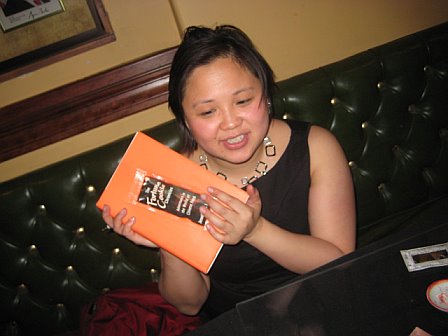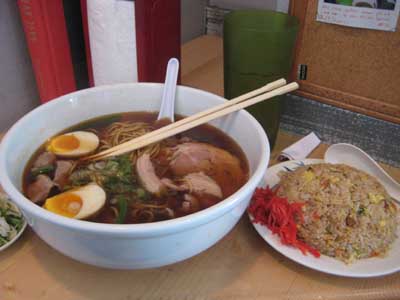July 1, 2008

Considering that many -- if not most -- Asians are allergic to alcohol, it's amazing how much the culture of alcohol is part of society in Japan. I guess it's the same all over the world, but since I'm very allergic to alcohol, I'm just out of the loop when it comes to booze.
You're probably familiar with the nightly practice of businessmen going out with their fellow "salarymen" after work and dining and drinking themselves into a stupor before trudging home to the families they hardly see. I can sip half a glass of beer and I turn bright red and splotchy, my eyes glow in the dark and I get dizzy as hell. It was hard to go out drinking in high school when my face gave myself away whenever I stumbled home and mom was up waiting for me. I guess if I were with co-workers who were all equally red, I wouldn't have been so self-conscious.
Anyway, I recently came across what looked like a cool soft drink at
Pacific Mercantile, the Japanese grocery store in downtown Denver, and I realized that Japan's alcohol culture starts earlier than I thought, and in insidious ways.
I saw a display for bottles of a drink called "Kodomo no Nomimono," with a cute retro 1930s illustration of a child on the label, and the words, which translate as "Children's Drink" written out in
hiragana, the simplified alphabet that's familiar to Japanese school kids.
The bottles were on sale -- buy one, get one free -- so I bought one to try, and got one for my friend Jordan, the "
Energy Examiner" for Examiner.com. He
wrote about Kodomo no Nomimono, and found to his shock that the stuff is marketed as a beer for kids by its manufacturer, Sangaria, the makers of the popular lemonade-flavored pop, Ramune.




 Considering that many -- if not most -- Asians are allergic to alcohol, it's amazing how much the culture of alcohol is part of society in Japan. I guess it's the same all over the world, but since I'm very allergic to alcohol, I'm just out of the loop when it comes to booze.
You're probably familiar with the nightly practice of businessmen going out with their fellow "salarymen" after work and dining and drinking themselves into a stupor before trudging home to the families they hardly see. I can sip half a glass of beer and I turn bright red and splotchy, my eyes glow in the dark and I get dizzy as hell. It was hard to go out drinking in high school when my face gave myself away whenever I stumbled home and mom was up waiting for me. I guess if I were with co-workers who were all equally red, I wouldn't have been so self-conscious.
Anyway, I recently came across what looked like a cool soft drink at
Considering that many -- if not most -- Asians are allergic to alcohol, it's amazing how much the culture of alcohol is part of society in Japan. I guess it's the same all over the world, but since I'm very allergic to alcohol, I'm just out of the loop when it comes to booze.
You're probably familiar with the nightly practice of businessmen going out with their fellow "salarymen" after work and dining and drinking themselves into a stupor before trudging home to the families they hardly see. I can sip half a glass of beer and I turn bright red and splotchy, my eyes glow in the dark and I get dizzy as hell. It was hard to go out drinking in high school when my face gave myself away whenever I stumbled home and mom was up waiting for me. I guess if I were with co-workers who were all equally red, I wouldn't have been so self-conscious.
Anyway, I recently came across what looked like a cool soft drink at  We had dinner last night at the venerable
We had dinner last night at the venerable  I just had a great meal at our favorite restaurant in San Francisco's Japantown, Iroha. It's a noodle house that serves up a great deal: A lunch combination special of ramen topped with a couple slices of pork, and gyoza dumplings on the side.
The restaurant is more crowded than usual, and filled with lots of non-Japanese who are here for the first time. That's because J-Town in general is hopping this weekend. It's the second weekend of the annual Cherry Blossom Festival, or Sakura Matsuri. There are vendors with booths selling everything from junky trinkets to high-class jewelry, lots of food and stages of performers and martial arts demonstrations, all with a Japanese focus.
But there's also a Japanese American undercurrent, with young people flocking to stores that specialize in anime and Jpop music. It's a cool mix of traditional and contemporary -- much like J-Town itself.
I just had a great meal at our favorite restaurant in San Francisco's Japantown, Iroha. It's a noodle house that serves up a great deal: A lunch combination special of ramen topped with a couple slices of pork, and gyoza dumplings on the side.
The restaurant is more crowded than usual, and filled with lots of non-Japanese who are here for the first time. That's because J-Town in general is hopping this weekend. It's the second weekend of the annual Cherry Blossom Festival, or Sakura Matsuri. There are vendors with booths selling everything from junky trinkets to high-class jewelry, lots of food and stages of performers and martial arts demonstrations, all with a Japanese focus.
But there's also a Japanese American undercurrent, with young people flocking to stores that specialize in anime and Jpop music. It's a cool mix of traditional and contemporary -- much like J-Town itself.  Hot stuff: Orochon Ramen lets you choose your level of heat. I opted for #3 and it was pretty damned warm.
Hot stuff: Orochon Ramen lets you choose your level of heat. I opted for #3 and it was pretty damned warm.